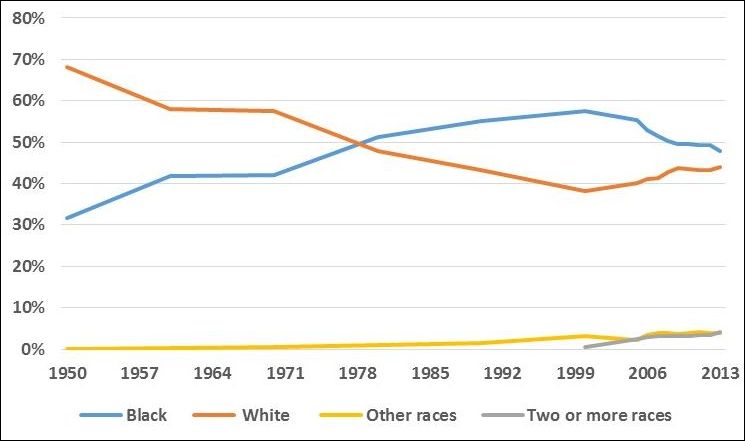by James A. Bacon
The City of Richmond reached a quiet demographic tipping point about five years ago: It stopped being a majority-African-American city. Movement of blacks into suburban jurisdictions, an influx of whites into the city and a small-but-measurable increase in other races, including people who self-identified with two races, all contributed to the change.
Richmonders appear not to notice. There is a still a widespread perception of Richmond as a black-majority city (and, in fact, blacks still outnumber whites, although by a tiny margin.) African-Americans still dominate city government. Richmond has a black mayor, a black police chief, a black sheriff, a black school superintendent and a black commonwealth’s attorney.
I find it fascinating how little attention anyone is paying to the demographic shift – and what that lack of attention says about our times.
It wasn’t all that long ago — around 1980 — when Richmond, once a white-majority city, tipped into a black-majority jurisdiction, according to Hamilton Lombard, a demographer writing in StatChat, the Weldon Cooper Center for Public Service blog. Political power shifted to blacks for the first time in a city that had been synonymous with Jim Crow segregation and massive resistance to integration. White flight, part of a national phenomenon, was highly publicized at the time, and local politics were racially polarized.
Now that the demographic pendulum has swing back, nobody seems to notice. Richmond City Council now is majority white, but the shift in racial representation has not resulted in calls for white racial patronage. Everybody’s focus seems to be on promoting economic development, addressing poverty and making city government function more effectively. (One can argue how well the city is faring on those fronts, but that’s where the focus is.)
Race is less of a divider in other ways. Although there remain hard-core pockets of concentrated, African-American poverty, most neighborhoods are less segregated than they once were, Lombard contends. “The concentration of blacks is beginning to lessen; in 2000, 13 census tracts in Richmond were over 95 percent black, but by 2013 only 4 of these census tracts were still over 95 percent black,” he writes. “During this same time period, the black population in the Richmond metro area’s suburban counties grew quickly as many of the city’s black residents moved to them.”
While the city continues to expand its housing base through infill and redevelopment, allowing for continued population growth, Lombard thinks it may never return to white-majority status. One big reason:
The number of people living in Richmond who describe themselves as being more than one race has tripled since 2000 to a little under 9,000. This is likely in part due to Virginia having the highest rate of marriage between blacks and whites in the country, but also because as racial identity means increasingly less today, many people are identifying with more than one race, some even writing in their own race. Considering how much publicity the last major demographic change in Richmond received, the lack of attention given to the current one reveals how much Richmond itself has changed.
Racial identity politics is such a powerful force nationally that it’s hard to imagine that Richmond — the former capital of the Confederacy and locus of massive resistance, as some like to continually remind us — could be so lackadaisical and unaware of a shift that once would have been regarded as so profound. That is a sign of tremendous progress, and it augurs well for the future.



